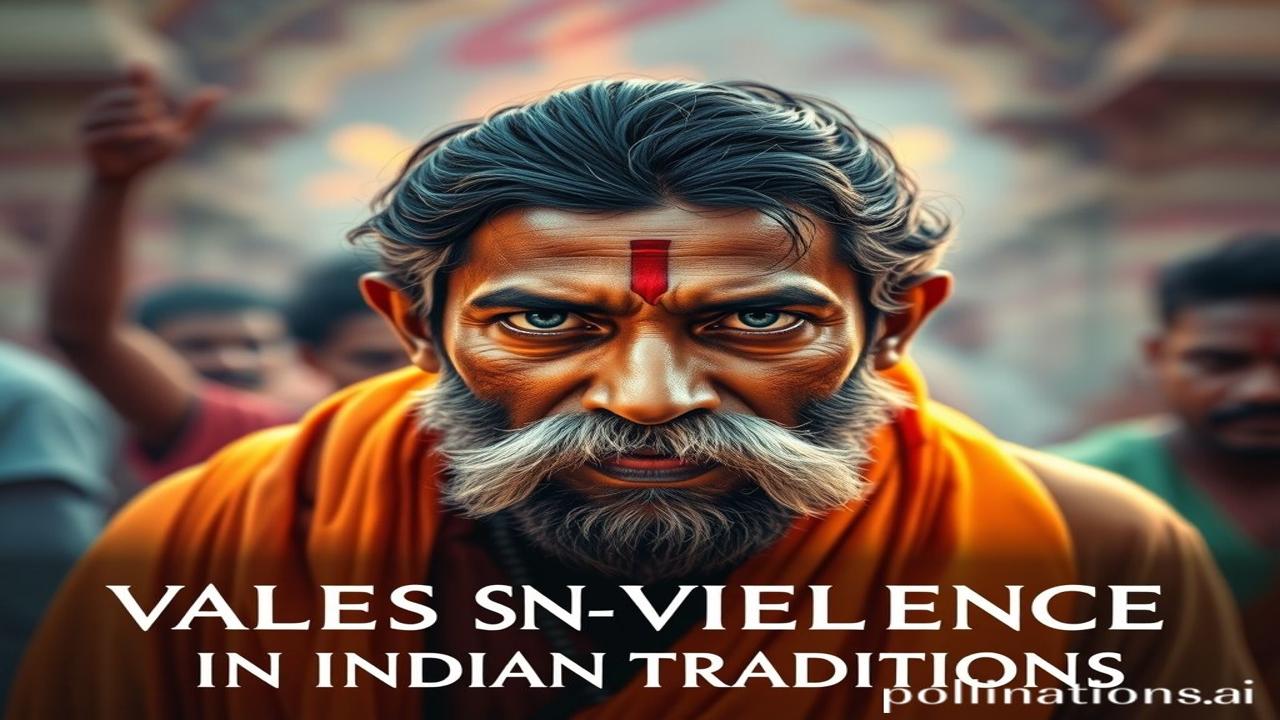Ahimsa Ki Goonj: Echoes of Non-Violence in India’s Soul
Kabhi kabhi aisa lagta hai jaise Bharat ki mitti mein, uski hawa mein, ek ajeeb si shanti hai. Yeh shanti na sirf hamare mandiron aur ashramon mein milti hai, balki har us dil mein basti hai jo Gandhi ji ki “he Ram” se prerit hai. Lekin kya aap jaante hain ki yeh ahimsa, ya non-violence, ki parampara kitni purani hai? Iska silsila sirf Gandhi ji tak hi seemit nahi hai, balki yeh toh hamare itihaas ki gehraiyon mein basa hua hai. Chaliye, chalte hain us safar par, jahaan hum iske rango ko aur bhi kareeb se dekhenge.
Bharat Ki Dharti Par Ahimsa Ka Udai: A Historical Tapestry
Ahimsa, yaani non-violence, koi nayi cheez nahi hai. Its roots run deep into the rich soil of Indian philosophy and spirituality. From the ancient scriptures of Hinduism and Jainism to the teachings of Buddhism, the principle of non-violence has been a cornerstone. Ye koi sudden trend nahi tha, but a gradual unfolding over centuries.
-
Vedic Kal (1500-500 BCE): Though Vedic texts show evidence of animal sacrifice, the seeds of ahimsa were already being sown. The concept of ‘Rta’ – cosmic order – implied a deep respect for all life.
-
Jainism aur Buddhism Ka Prabhav: Jainism and Buddhism elevated ahimsa to a cardinal virtue. Mahavira, the 24th Tirthankara of Jainism, took non-violence to an extreme, advocating for the protection of even the tiniest insects. Gautam Buddha preached the Middle Path, emphasizing compassion and non-violence towards all beings.
-
Maurya Samrajya (322-185 BCE): Emperor Ashoka’s transformation after the Kalinga War is a legendary example. He embraced Buddhism and actively promoted ahimsa through his edicts, famously advocating for the welfare of humans and animals alike. This was monumental for ahimsa to be a main government value.
Yeh sirf philosophical concepts nahi the. They permeated daily life, shaping social norms and cultural practices.
Zameeni Sach: Ahimsa In Daily Life – Log Aur Jeevan
Imagine a day in ancient India. Ma Rukmini, a Jain woman, carefully sweeps the floor before her, ensuring she doesn’t inadvertently step on any living creature. A Buddhist monk walks slowly, mindfully, avoiding harming any insects along his path. A farmer plows his field with oxen, treating them with respect and care.
-
Kings and Commoners: Ahimsa wasn’t just for monks or saints. Rulers like Ashoka made animal slaughter illegal and opened hospitals for animals. Commoners practiced vegetarianism and donated to animal shelters.
-
Artisans and Craftspeople: The concept influenced art as well. Buddhist art showcases serene and compassionate figures. Jaina art emphasizes meticulous care to avoid harming even the smallest of creatures.
-
Dialogue Style: “Are bhai,” shouts a farmer to his neighbor, “careful with that stone! You might disturb the ants!” The awareness was woven into every conversation.
Ahimsa was not just a concept; it was a lived reality, a way of life that touched every aspect of Indian society.
Dharohar Aur Pehchan: Ahimsa Today – Echoes in Modern India
Aaj bhi, ahimsa ki goonj Bharat mein sunai deti hai. From the peaceful protests against injustice to the vegetarian options on almost every menu, the legacy of non-violence persists.
-
Gandhi’s Influence: Mohandas Karamchand Gandhi, the father of the nation, revitalized the principle of ahimsa and used it as a powerful tool for achieving independence. His philosophy of Satyagraha, based on truth and non-violent resistance, inspired movements across the world.
-
Rituals and Festivals: Vegetarianism remains widespread, especially amongst certain communities. Many festivals emphasize compassion and giving to those in need. Diwali, the festival of lights, is often celebrated with vegetarian feasts and a focus on inner peace.
-
Bharatiyata and Modern Identity: Ahimsa is deeply intertwined with what it means to be Indian – a sense of compassion, tolerance, and respect for all life forms. It offers an alternative to violence and hatred, promoting peace and harmony. It’s a cornerstone of ‘Bharatiyata’.
Mazedaar Tathya Ya Bhram-Bhanjak: Myths and Realities
Log samajhte hain ki ahimsa ka matlab hai kamzori. Lekin asli sach yeh hai ki ahimsa mein bahut shakti hoti hai. Gandhi ji ne is shakti ko dikhaya. It takes immense courage and discipline to remain non-violent in the face of adversity.
Ek aur bhram yeh hai ki ahimsa sirf Hinduon ki parampara hai. Lekin jaisa ki humne dekha, Jainism aur Buddhism ne bhi isme bada yogdaan diya hai. Ahimsa is a shared heritage of India, transcending religious boundaries.
Drishya Aur Bhavnayein: A Sensory Tapestry of Peace
Imagine the scent of sandalwood incense wafting through a temple, the soft chants of monks echoing in the air, the feel of smooth stone under your feet as you circumambulate a stupa. This sensory richness underscores the peaceful atmosphere associated with the practice of ahimsa. The quiet hum of a spinning charkha, Gandhi ji’s symbol of self-reliance and non-violent resistance, fills the air with a sense of purpose.
Antim Vichar Ya Uddharan: A Closing Thought
“Ahimsa Paramo Dharmah” – Non-violence is the highest duty. This Sanskrit phrase encapsulates the enduring relevance of ahimsa in our lives. Let us strive to embody this principle in our thoughts, words, and actions, creating a more peaceful and compassionate world for all. Ahimsa sirf ek idea nahi hai, yeh ek jeevan shaili hai. It’s more than just an ideal, its a way of life.
